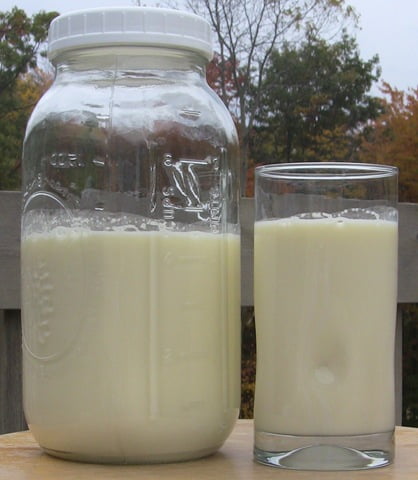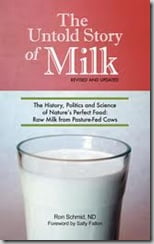
Recently a reader, Kim, asked a question here in the comments and since this is a question I get a lot, I thought I’d let all of you take a rip at answering it:
Rookie here. I am not yet at the point of using raw milk…we have lived on nonfat and are slowly working our way up to raw whole milk. I really want to try this waffles/pancakes recipe..BUT the thought of leaving flour, milk and yogurt sitting out on my counter all night is so contrary to what I have always thought to be right about dairy products and refrigeration that I am very squeamish about trying it. Please, can someone tell me how/why this is safe? Thank You!”
OK readers, have at it, what would you say to Kim?
- Have you read through these Rookie tips?
- More about raw milk in case you were wonderin’
- Recipes & Ideas for making kitchen time easier
-
Here’s a book on the topic that you’ll definitely want to read: The Untold Story of Milk
- Learn why raw milk is the best milk for us: Raw Milk Benefits and Information: Q & A with Mark McAfee


Heather H says
I can’t get raw milk either. So, if I were to make Kelly’s waffle recipe, you guys are saying to soak in just the yogurt overnight, and then add the milk with the rest of the ingredients in the morning? or simply soak with milk in the fridge overnight?
KitchenKop says
Heather, you’ll need to soak with something acidic like whey, lemon juice, ACV, yogurt, kefir, something like that. 🙂
Kel
Janeen says
Your right – I do need an “About Us” page! WHy that hasn’t happened yet, I don’t know! Got busy with the food and forgot to finish the website essentials, I guess!
I’ll find you on Face Book, OK – might have a picture or 2 on there. Iit’s mostly kids and hubby too though – I really need to give the camera to other people!
Janeen says
Yes – do leave the lid off once it’s on the counter! Off-flavours develop and/or funky molds when it can’t breath. Just put a light cloth over with clothes pins.
I found this out the hard way by wreckin about 5 gallons of cream with the lids on when I set them out for a day to warm up – made this horrible “chemical-ey” taste all through the cream! The pigs got those pails – I could have cried!
Great to meet you inperson Kelly (last weekend (although you probably don’t remenber me!)
KitchenKop says
Janeen,
I surely probably WOULD remember you if you had a picture of yourself SOMEWHERE on your site, which you DON’T! I just spent a while looking, and met every animal you raise, plus your hubby and kids, but none of you, LOL! 🙂
Kelly
KitchenKop says
Julia, I’m pretty sure that under the mold it would’ve been fine, but I hope someone with more experience at this will jump in and answer your question better. 🙂
Kelly
Julia says
I tried my first experiment with raw milk – leaving a small glass jar full on the counter for a few days – but a whiteish mould grew on the top! Underneath the mould and cream the milk looked like clabber but I was too scared to try it and threw it out. The jar was sterilised, but maybe the lid should have been left off? Has this happened to anyone else? If I spooned off the mould would it still be safe? Would be grateful for any tips as hate throwing out the precious and expensive raw milk!
Barbara Grant says
The last time I left a quart of raw milk on the counter to clabber, it took 5 days. It was delicious!! I tried it with goat milk but after 10 days it had not separated, so I threw it out.
Alex at A Moderate Life says
I would add only this. If you are leaving raw milk out, it contains the enzymes and lactobacillus bacteria needed to clabber the milk naturally. It sours but it does so in a good way. leaving pasteurized milk out that does not have the enzymes or the good bacteria will cause the milk to GO BAD. That said, if you ADD in the bacteria from whey or yogurt, then you are cool! 🙂 I had fun making my first raw milk whey a few weeks back and that kind of freaked me out because it took a LONG while for it all to separate, like a couple of days! Leaving milk in flour overnight was a piece of cake! 😉 Best of luck and Kim, you came to the right place for answers! Kel is a rock star of real food! 🙂
Kim says
Thank you for taking the time to respond here. I think I’ve got it! A whole new world! I am anxious to try this now!
Jeanmarie says
Please let us know how your experiment goes!
Jeanmarie says
There’s not much to add, the first 6 commenters have covered it. OK, if pressed, I would only expand on the idea of getting comfortable with friendly bacteria. Maybe it helps to realize that major, important biological processes of all life depend on the work of microorganisms. We’ve been taught to keep scrupulously clean, and while there’s definitely a place for sanitation, our society is definitely doing it to the point of overkill, literally. Bacteria help protect our skin, they digest our food and make various vitamins in our gut, they compost dead organic matter and return elements to the soil in a form that the soil can use to feed new plants and new life. Dead bodies and plant matter would pile up and smother the living, should there be any left, if it weren’t for the important work of “degraders.”
On a more pleasant note, humankind has learned to work with all kinds of friendly yeasts and bacteria to make delicious, nutritious cultured foods throughout history, in the absence of refrigeration. Sourdough breads, beer, wine, chocolate, various condiments such as the original forms of ketchup, lacto-fermented vegetables, sauerkraut, pickles, chutney, mead, black tea and oolong tea, kombucha, water kefirs and lacto-fermented sodas, to name a few, wouldn’t be possible without the wonderful world of microbes. (OK, raw food faddists are now eating raw cacao, but chocolate has traditionally been fermented, and I can only assume there’s a good reason, probably to reduce phytic acid.) Oh, and of course dairy ferments: cheese, cultured buttermilk and butter, kefir, piima, yogurts of every kind, creme fraiche, and did I mention cheese?
Life on earth is not possible without the important work of various microbes, and it’s a lot less delicious without the ones that do the above kitchen work for us. The vast majority of them are friendly/useful or neutral to us, only a tiny minority are pathogenic (and indeed are to be taken seriously). As others pointed out, you don’t want to use pasteurized milk to soak things overnight on the counter. Use yogurt or kefir or raw milk. There are lots of us out here who can attest that it won’t sicken you! The difference is culturing vs rotting. Culturing–good, rotting–bad (in the context of your kitchen, that is. It’s just fine in your compost pile).
Take the step! Love your microbes and they will love you.
Heather H. says
Milk was never meant to be refridgerated in the first place. The normal process that our ancestors followed was:
1. drink the milk fresh from the cow on the day of milking
2. left over milk was allowed to sit at room temp until the fat/cream rose to the top.
3. Skim the fat/cream off the top and make butter
4. “clabber” (fancy word for ferment) the remaining milk to make yogurt, to soak grains, to make lacto-fermented beverages, etc…
Refridgeration is a fairly new modern concept. Bacteria is GOOD! Raw milk that is un-pasteurized and un-homogenized is the way God intended for us to consume it in the first place. Dead milk is poison, and it would be better for you to drink water and just forget about milk period, rather than consume that.
Trust me sister, I am the lacto-fermentation Queen! Besides water, all we drink in our house is lacto-fermented beverages. We soak every grain in yogurt or kefir. We are very lucky to have an awesome source of Raw Milk here in Michigan, that ONLY eats grass! There is always a funky jar of something crazy fermenting on my kitchen counter. Its fun!
Start small. you’ll be amazed at the results in your health in the long run.
Jessie says
I make this pancake recipe fairly often
https://www.suegregg.com/recipes/breakfasts/blenderbatterwaffles/blenderbatterwafflesA.htm
But I only leave it out at room temp when I use yogurt (we’re not able to get raw milk at the moment). If I’m using pasteurized milk and lemon juice, I keep it in the fridge, especially in the summer.
Jen says
I was thinking the same thing, Pat. Definitely don’t do this with pasteurized milk… it’s dead. Yogurt would be fine, as long as it contains active cultures of the good stuff (bacteria).
Pat Winter says
Since you are using pasteurized milk to make the recipe and pasteurized milk rots, rather than sours, I would do the recipe under refrigeration. I would consider switching quickly to raw and real milk. Just my not so humble opinion, Pat
EllaJac says
Here’s my understanding: Leaving stuff out at room temp WILL grow bacteria faster than refrigeration. The key here is that the bacteria you’re growing is GOOD STUFF. The yogurt is cultured, you’re adding whey, whatever. In fact, the lactic-acid producing bacteria does just that – and lactic acid will in turn inhibit the growth of harmful bacteria (not sure how much this plays into the dairy stuff, but it’s how sauerkraut happens). So yes, you’re letting bacteria grow, but it’s the “good kind” and presumably this combination will work it’s magic on the grains and make them better for you.
If it’s any comfort, we do this often (right now, in fact.. raw milk about to ‘turn,’ some yogurt, water, and whole wheat flour preparing to be pancakes in the morn), and without any ill effects. I’ve even used (refrigerated) plain yogurt a YEAR past it’s expiration date… it was fine (it’s already ‘gone bad’ if that’s how you define bacterial action)!
It took me a while to get used to the idea too, until I began to understand that not ALL bacteria were harmful. I could grow the good ones with a little purposeful planning… homemade “pro”biotics!
Kacie says
Beats me! I hope you will answer in a future post!